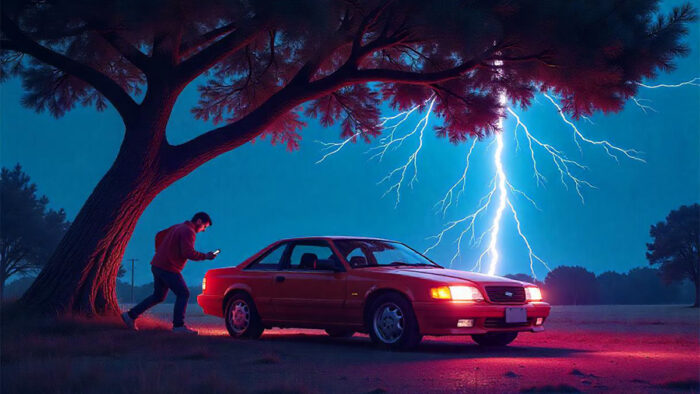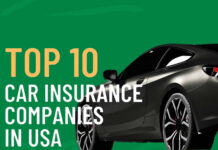Car insurance will cover lightning strikes if you have comprehensive coverage. If your car was struck by lightning while you are driving or in a place where it is parked and you have comprehensive coverage, the cost of repair will be covered by the policy. On the other hand, if you don’t have comprehensive coverage in your car insurance policy, you will be responsible for paying all expenses related to the repair of your vehicle.

Notwithstanding, it is important to know the specifics of your car insurance policy because different plans provide different coverage. The circumstances can also change depending on things like the type of coverage you have and the magnitude of the damage.
How Does Car Insurance Cover Lightning Strikes?
As mentioned earlier, car insurance will only cover lightning strikes if you have comprehensive coverage. This type of coverage protects against lightning strikes, fire, and other types of losses. Aside from that, comprehensive coverage offers financial protection and security in the event of theft, vandalism, and other damage caused by natural disasters.
Once your insurance company approves your claim, they will provide you with a specific amount of money to cover the expenses associated with the damage to your car. For those who do not have comprehensive coverage on their auto insurance policy, the cost of repair for the damage incurred by the lightning strike will be paid out of their personal pocket.
What Type of Insurance Covers Lightning Strikes?
Damages from lightning strikes are usually covered by comprehensive auto insurance. Comprehensive insurance offers protection against events other than collisions, such as theft, vandalism, fire, and natural catastrophes. This type of coverage can assist with paying the cost of repairs, excluding applicable deductibles, if a lightning strike causes damage to your car, including electrical system failures, fires, or other associated issues.
However, it’s crucial to check the specifics of your policy to make sure you have enough protection against unforeseen situations such as lightning strikes. Coverage varies between insurance companies; hence, the need for you to understand when certain risks or perils are covered and when they are not.
What Should I Do If I Experience Lightning Strikes While Driving?
There are times where things happen expectedly and certain situations are beyond our control. If lightning strikes while you are driving, consider the following tips:
• Pullover immediately
To avoid further issues, pull over and ensure your safety as soon as your notice lightning strikes. Park your car in a safe location that is clear of electrical lines or trees during storms, as these might pose additional risks. Choose a level, open space that is free from potential dangers.
• Turn on your hazard lights
Once you have parked your car in a safe location, turn on your hazard lights in order to let other drivers know that you are stationary. This also helps to keep your car visible to other divers and helps prevent accidents in server weather conditions.
• Turn off your vehicle
In order to reduce the risk of electrical surges, it is advisable to turn off the engine of your car. This would help to protect the electrical systems of your car from potential lightning strikes.
• Avoid metals
After turning off the engine of your car, remain inside and refrain from touching any metal parts of the car, such as gear shift and steering when. A car metal frames serve as a Faraday cage, which keeps people safe during lightning strikes, but it is advisable to avoid direct metal contact to lower your risk.
• Stay inside the vehicle
Until the lightning stops, remain in your car. As long as you stay inside the car, you will be protected from lightning and other storm-related risks.
• Monitor weather conditions
Turn on your radio or keep an eye on weather updates on your phone, if feasible. Knowing how the storm is mobbing will enable you to know when it is safe for you to start driving again. Once the storm is over, drive with caution. Keep an eye out for hazards that may have developed during the storm, such as fallen debris and flooded areas. Also, inspect your car properly to ensure it is in good condition before driving.
By following the aforementioned tips, you can ensure your safety and that of other drivers if you are in a situation where your car got struck with lightning or other severe weather conditions.
How Do I File A Claim For A Lightning Strike?
If you happen to experience a lightning strike while driving and it causes severe damage to your vehicle, you can file a claim, provided you have comprehensive coverage. The best thing is to reach out to your insurance provider immediately you notice the extent of damage the lightning strike caused to your vehicle.
You will be required to provide certain details backed up with proof about how the incident played out. If you have photos of the damage, it would go a long way in making the claim process faster.
If the claim was approved by your insurer, the cost of repair and replacement of parts of your vehicle will be covered. Your insurance provider will decide whether the fund for repair will be sent to you or the repair shop. Either way, all related expenses will be settled accordingly.
FAQs
How do I prove my car got damaged by lightning strikes?
If you are involved in any type of accident, it is important to take photos and videos of the outcome; this also applies to accidents caused by lightning strikes. You can prove that your car was damaged by lightning through pictures and videos of the level of damage incurred. You can also reach out to a mechanic to give a written explanation of the fact that your car was damaged by lightning.
How can I tell if my car was struck by lightning?
There are several ways to know when your car was damaged by lightning strikes; the most obvious one is electrical problems leading to your car not functioning or starting as it should. If you also notice damage, such as shattered windows and peeled paint, it may be caused by a lightning strike.
Can I get additional coverage for natural disasters?
Of course! Most insurance companies offer riders specifically designed to provide coverage for natural disasters. Reach out to your insurance provider and ask if there are additional coverage options that can be used to enhance your protection in severe weather conditions.



